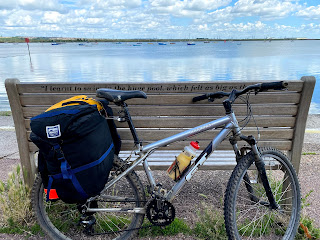This year the world slowed down around me, and I slowed too: my body told me it was time to stay close to home, and by mid-summer I was ill enough that walking half a mile was plenty.
But I was looking far beyond the small fields I could wander in. A piece of luck linked me with the artist Ardyn Halter, 3000 miles away in Israel. Together we were asked to explore the idea of A Common Place, alongside writers and artists from across the world, brought together by the Eames Gallery and 26.
Our pairings were random - our names literally pulled from two hats and called out over Zoom in late June as the heat rose outside and the roads stayed empty. Though the world beyond our doors was closed we were making connections - and the next day Ardyn and I spoke for the first time.
Ardyn lives in Israel and I'm East Sussex, and we didn't know each other's work before that first conversation. How did we begin to find our common place? I'm not sure I remember exactly, but my notes are scattered across the page ...
WATER
read the water
strong waves
fear of below
different person each time
LAYERS
coming home
what colour is feeling?
maps
memories
joy and chemistry
never entering same water twice
Some current had pulled our conversation to the water we share - my local, silty river Medway, and the Mediterranean where Ardyn swims daily before dawn. Since the beginning of this year I've been slowly travelling down the Medway towards the sea - swimming, walking, canoeing my way down the river I've known intimately since I was a baby, to a sea I barely know. That sea is connected to all sea, just as the land beneath my feet here, miles inland, flows into the river and on to the sea. This time of year - mid-December - I can clearly hear the water in the soil trickling into the tiny tributaries that gather over the fields and carry this morning's rain all the way to Israel, maybe, if it doesn't get distracted.
Water is slow, even when it moves fast - the rivers are filling and moving quickly after a week of rain here, but on every bend, there's an eddy, a nook where water pauses. Early sun lifts mist from the fields, carrying the water back into the air. Air, earth, water, all one.
My route down the river has slowed right down. I'm getting stronger and can walk a handful of miles now, but the world outside is closed again - I've almost reached Rochester, but it's out of bounds. So, like the water beneath my feet, I'm trickling slowly, wandering almost at random in the fields, up the hills and down the valleys where the streams gather.
But just look at the painting that Ardyn made, Sea Swim. Isn't it utterly gorgeous? It has all the emotion and sensation of the moment swimmer and sea come together. I love it.
And I have a poem, Flow, written after a summer of slow swimming in cool water on searingly hot days. My one constraint was that it must be 62 words exactly. It grew from rough notes made on a day after a walk along a tiny stream, thinking about tides, and from every swim I've ever slipped into:
A Common Place is at the Eames Fine Art Gallery until 24 December 2020.




















